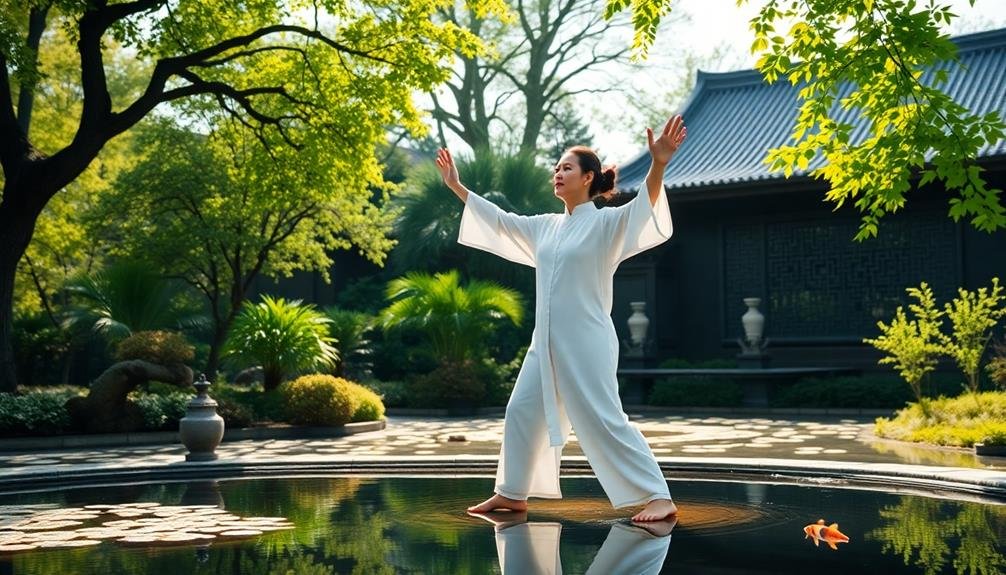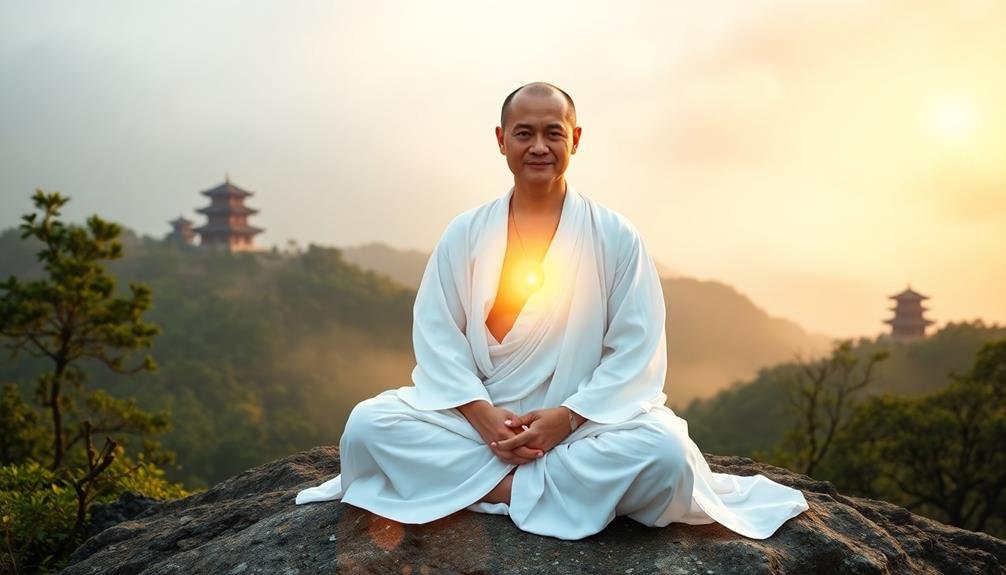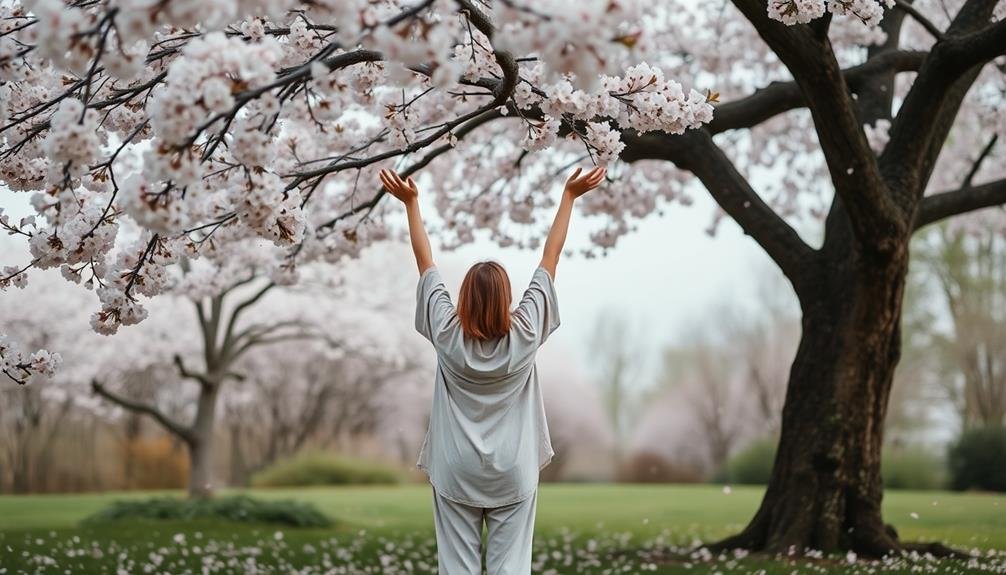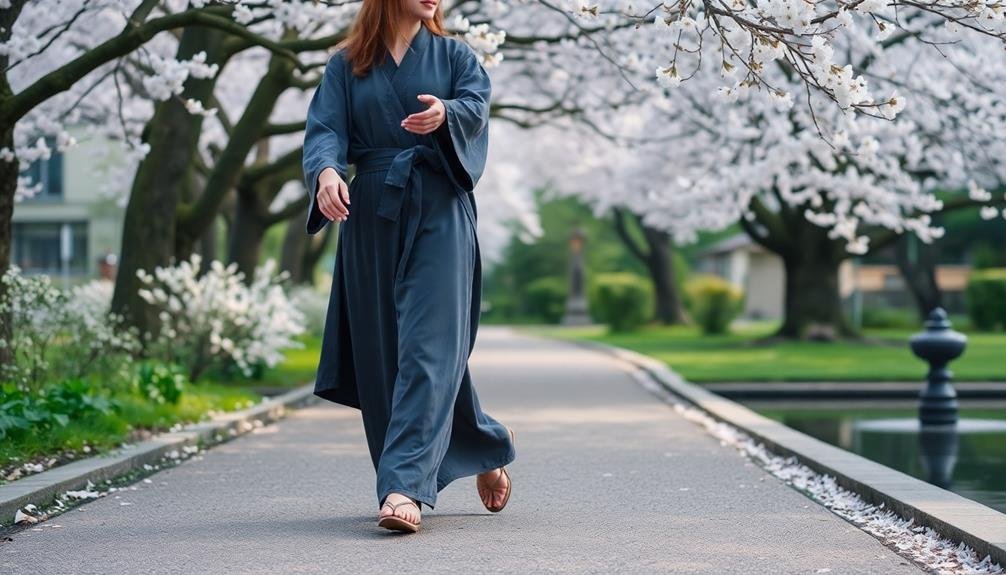You'll find effective anxiety relief with these top online Qigong routines: Eight Pieces of Brocade, Five Elements Qigong, Taoist Inner Smile Meditation, Breathing Sphere Exercise, Shaking the Tree Qigong, Standing Meditation for Grounding, Qigong Walking Meditation, Lotus Rises Through Water, Crane Spreads Its Wings, and Mindful Qigong for Stress Release. These practices combine gentle movements, breathing techniques, and visualization to calm your mind and body. They're easy to learn and can be done in short sessions, making them perfect for daily practice. By incorporating these routines into your life, you'll develop powerful tools to manage stress and promote overall well-being. Discover how these ancient techniques can transform your approach to anxiety management.
Eight Pieces of Brocade

The Eight Pieces of Brocade is a powerful Qigong routine that's perfect for anxiety relief. This ancient Chinese exercise sequence consists of eight simple movements that promote relaxation, improve circulation, and balance your energy. You'll find numerous videos and tutorials online demonstrating these exercises, making it easy to learn and practice at home.
Each "piece" in the routine targets specific areas of your body and mind. For example, the first movement, "Holding up the Sky," helps stretch your spine and stimulate your nervous system. "Drawing the Bow" strengthens your arms and shoulders while improving focus.
As you progress through the sequence, you'll notice your breathing becoming deeper and more rhythmic, which naturally calms your anxious thoughts.
You can perform the Eight Pieces of Brocade in about 10-15 minutes, making it an ideal practice for busy schedules. Start your day with this routine to set a calm tone, or use it as a midday break to reset your mind.
With regular practice, you'll likely experience reduced anxiety, improved sleep quality, and increased overall well-being.
Five Elements Qigong
Another powerful Qigong practice for anxiety relief is Five Elements Qigong. This routine is based on the traditional Chinese concept of five elements: Wood, Fire, Earth, Metal, and Water. Each element corresponds to specific organs, emotions, and movements. By practicing Five Elements Qigong, you'll balance these elements within your body, promoting overall well-being and reducing anxiety.
To perform Five Elements Qigong, you'll move through a series of gentle exercises, each focusing on a particular element. As you practice, visualize the associated colors and imagine the energy flowing through your body. Here's a quick overview of the elements and their connections:
| Element | Organs | Emotion | Color |
|---|---|---|---|
| Wood | Liver, Gall | Anger | Green |
| Fire | Heart | Joy | Red |
| Earth | Spleen | Worry | Yellow |
| Metal | Lungs | Grief | White |
| Water | Kidneys | Fear | Blue |
Taoist Inner Smile Meditation

One particularly soothing Qigong practice for anxiety relief is the Taoist Inner Smile Meditation. This technique involves visualizing a gentle smile radiating through your body, promoting relaxation and positive energy flow.
You'll start by sitting comfortably and focusing on your breath, then imagine a warm, loving smile spreading from your face to your internal organs.
As you practice the Inner Smile, you'll cultivate three key benefits:
- Reduced stress: The act of smiling, even internally, triggers the release of endorphins and serotonin, naturally lowering stress levels.
- Improved emotional balance: By directing positive energy to different parts of your body, you're addressing emotional blockages and promoting overall well-being.
- Enhanced mind-body connection: This meditation strengthens the link between your mental state and physical health, fostering a sense of wholeness.
To begin, focus on your heart, liver, and lungs, imagining each organ bathed in a warm, healing light.
As you progress, extend this practice to other body parts. Regular practice of the Taoist Inner Smile can considerably reduce anxiety symptoms and promote a sense of inner peace.
Breathing Sphere Exercise
Imagine a glowing sphere of energy in your lower abdomen as you begin the Breathing Sphere Exercise.
As you inhale, visualize the sphere expanding, and as you exhale, see it gently contracting.
This calming visualization, coupled with controlled breathing, can effectively reduce stress and promote a sense of inner peace.
Calming Visualization Technique
Visualize a glowing sphere of energy in your abdomen as you practice this calming Qigong technique.
Begin by standing with your feet shoulder-width apart, knees slightly bent, and arms relaxed at your sides. Close your eyes and take a few deep breaths, focusing on the sensation of air entering and leaving your body.
As you continue breathing deeply, imagine a warm, golden sphere of light forming in your lower abdomen. With each inhale, visualize the sphere growing brighter and larger. As you exhale, picture the sphere's energy spreading throughout your body, releasing tension and promoting relaxation.
To enhance the effectiveness of this visualization technique, incorporate these key elements:
- Engage your senses: Feel the warmth of the sphere, hear a gentle hum, and see its radiant glow.
- Use color: Experiment with different colors for the sphere, choosing ones that resonate with calmness and tranquility.
- Practice mindfulness: Stay present in the moment, acknowledging and releasing any intrusive thoughts.
Maintain this visualization for 5-10 minutes, gradually allowing the sphere to fade as you open your eyes and return to your surroundings.
Stress-Reducing Breath Control
Building on the calming effects of visualization, the Breathing Sphere Exercise offers another powerful tool for stress reduction. This technique combines breath control with mental imagery to create a deeply relaxing experience.
To begin, sit comfortably and close your eyes. Imagine a sphere of light in front of you. As you inhale slowly through your nose, visualize the sphere expanding. As you exhale through your mouth, see the sphere contracting. Focus on making your breaths slow, deep, and rhythmic.
As you continue this breathing pattern, imagine the sphere's energy flowing into your body with each inhale, filling you with calm and positivity. With each exhale, picture stress and tension leaving your body and dissipating into the air.
Practice this exercise for 5-10 minutes, gradually increasing the duration as you become more comfortable. You'll likely notice a significant reduction in anxiety and an increased sense of overall well-being.
The Breathing Sphere Exercise is particularly effective when you're feeling overwhelmed or need a quick stress-relief technique during your day.
Shaking the Tree Qigong

Shaking the Tree Qigong offers powerful anxiety relief through its combination of physical movement and energetic release.
You'll learn the proper technique for this exercise, focusing on loose, gentle shaking movements that start from your feet and move upwards through your body.
As you practice, you'll incorporate deep, rhythmic breathing to enhance the calming effects and promote a greater sense of relaxation.
Benefits of Tree Shaking
As a gentle yet powerful exercise, Tree Shaking Qigong offers numerous benefits for those seeking anxiety relief. This practice helps you release tension and negative energy stored in your body, promoting a sense of calm and relaxation.
By engaging in rhythmic shaking movements, you'll stimulate your nervous system and increase blood flow throughout your body, which can reduce stress and anxiety symptoms.
Tree Shaking Qigong also enhances your body awareness, allowing you to better recognize and address areas of tension or discomfort. As you practice, you'll find it easier to let go of racing thoughts and worries, focusing instead on the present moment and the sensations in your body.
The benefits of Tree Shaking Qigong extend beyond immediate anxiety relief:
- Improved flexibility and joint mobility
- Enhanced lymphatic drainage and detoxification
- Increased energy levels and overall liveliness
Regular practice of Tree Shaking Qigong can help you develop a greater sense of emotional resilience, making it easier to cope with daily stressors.
You'll likely notice improvements in your sleep quality, digestion, and overall well-being as you incorporate this simple yet effective technique into your anxiety management routine.
Proper Technique and Form
To fully harness the benefits of Tree Shaking Qigong, it's important to understand and practice the proper technique and form. Start by standing with your feet shoulder-width apart, knees slightly bent, and arms relaxed at your sides. Ground yourself by imagining roots growing from your feet into the earth.
Begin gently shaking your body, starting from your feet and moving upward. Allow the movement to flow naturally through your legs, hips, torso, arms, and head. Keep your movements loose and fluid, avoiding tension in any part of your body. Breathe deeply and naturally, synchronizing your breath with the shaking motion.
As you shake, visualize negative energy and tension leaving your body. Imagine you're a tree, releasing old leaves and stagnant energy. Maintain a relaxed facial expression and keep your jaw unclenched. Shake for 3-5 minutes, gradually increasing the duration as you become more comfortable with the practice.
To finish, slowly reduce the intensity of the shaking until you come to a complete stop. Take a moment to stand still and notice the sensations in your body. You may feel a tingling or warm sensation, indicating improved circulation and energy flow.
Incorporating Breath Work
Breath work plays an essential role in maximizing the benefits of Shaking the Tree Qigong. As you practice this routine, focus on coordinating your movements with your breath. Inhale deeply through your nose as you raise your arms, and exhale slowly through your mouth as you shake and release tension. This synchronized breathing helps oxygenate your body, calm your mind, and enhance the overall effectiveness of the exercise.
To incorporate breath work effectively into Shaking the Tree Qigong:
- Begin with a few deep breaths before starting the routine, centering yourself and setting an intention for your practice.
- Maintain a steady rhythm of inhaling for 4 counts and exhaling for 6 counts throughout the exercise.
- Visualize negative energy leaving your body with each exhale, promoting a sense of release and relaxation.
As you become more comfortable with the breath work, you'll notice its impact on reducing anxiety. The controlled breathing activates your parasympathetic nervous system, triggering a relaxation response. This helps lower your heart rate, decrease blood pressure, and alleviate stress.
Remember to stay mindful of your breath throughout the routine, allowing it to guide your movements and enhance your overall Qigong experience.
Standing Meditation for Grounding
Standing meditation, also known as Zhan Zhuang, is a powerful Qigong practice for grounding and anxiety relief. This simple yet effective technique involves maintaining a static posture for extended periods, allowing you to cultivate inner stillness and connect with your body's energy.
To begin, stand with your feet shoulder-width apart, knees slightly bent. Relax your shoulders and let your arms hang naturally at your sides. Imagine roots growing from your feet into the earth, anchoring you firmly. Gently shift your weight to find your center of balance.
As you stand, focus on your breath, allowing it to deepen and slow naturally. You'll likely experience various sensations as you practice, including tingling, warmth, or heaviness in your limbs. These are normal and indicate energy movement.
Start with short sessions of 2-5 minutes and gradually increase duration as you build stamina. You can practice standing meditation daily, ideally in the morning or evening.
This grounding technique helps calm your nervous system, reduce anxiety, and improve overall emotional balance. By regularly practicing standing meditation, you'll develop a stronger sense of stability and presence in your daily life.
Qigong Walking Meditation

While standing meditation offers profound benefits, incorporating movement into your practice can further enhance anxiety relief. Qigong walking meditation combines gentle movement with mindful breathing, creating a powerful tool for reducing stress and anxiety. As you practice, focus on each step, synchronizing your breath with your movements.
To perform Qigong walking meditation:
- Begin by standing tall, feet hip-width apart.
- Take a slow, deliberate step forward with your left foot.
- As you step, inhale deeply and raise your arms in front of you.
As you exhale, lower your arms and shift your weight onto your left foot. Repeat this process with your right foot, maintaining a slow, rhythmic pace. Allow your mind to focus solely on your movements and breath, letting go of anxious thoughts.
This practice not only calms your mind but also improves balance, coordination, and overall body awareness.
You'll find that the gentle, flowing movements help release tension in your muscles and joints. By combining movement with meditation, you're engaging both your body and mind in the anxiety-relief process, creating a more holistic approach to managing stress.
Lotus Rises Through Water
You'll find the "Lotus Rises Through Water" routine particularly soothing for anxiety relief.
This practice combines gentle, flowing movements that mimic a lotus flower emerging from water with stress-releasing breathing techniques.
As you perform the graceful motions, you'll focus on deep, rhythmic breaths, helping to calm your mind and relax your body.
Gentle Flowing Movements
Imagine a lotus flower gracefully rising through tranquil waters as you perform the "Lotus Rises Through Water" movement. This gentle flowing exercise embodies the essence of Qigong, promoting calmness and inner peace.
Begin by standing with your feet shoulder-width apart, knees slightly bent. As you inhale deeply, slowly raise your arms from your sides, palms facing up, mimicking the lotus petals opening. When your hands reach chest level, rotate your palms outward and continue lifting them above your head.
Exhale as you lower your arms, palms facing down, completing one full cycle. Repeat this fluid motion for 5-10 minutes, focusing on your breath and the serene imagery.
This practice offers numerous benefits for anxiety relief:
- Encourages deep, rhythmic breathing to activate the parasympathetic nervous system
- Promotes mindfulness by connecting movement with breath and visualization
- Releases tension in the shoulders, neck, and upper back, common areas of stress accumulation
As you continue this gentle flowing movement, you'll feel a sense of grounding and tranquility wash over you, much like the calm waters surrounding a lotus flower.
Stress-Releasing Breathing Techniques
The "Lotus Rises Through Water" movement can be enhanced by incorporating specific breathing techniques to amplify its stress-relieving effects. As you perform this gentle, flowing motion, focus on your breath to deepen the practice's calming impact.
Begin by inhaling slowly through your nose as you raise your arms, imagining you're drawing energy from the earth. Hold your breath briefly at the top of the movement, then exhale gradually through your mouth as you lower your arms.
Try counting your breaths to maintain a steady rhythm. Inhale for a count of four, hold for two, and exhale for six. This pattern, known as "4-2-6 breathing," helps activate your parasympathetic nervous system, reducing anxiety.
As you continue the lotus rising movement, visualize tension leaving your body with each exhale. You can also experiment with "ocean breath," where you slightly constrict your throat to create a soft, oceanic sound as you breathe. This technique, called ujjayi in yoga, can further promote relaxation and mindfulness during your qigong practice.
Remember to keep your breathing smooth and natural, never forcing or straining.
Crane Spreads Its Wings

Next in our lineup of anxiety-relieving Qigong routines is "Crane Spreads Its Wings." This graceful movement mimics the elegant motion of a crane extending its wings, promoting a sense of openness and release.
As you perform this exercise, focus on your breath and imagine tension melting away from your shoulders and chest.
To practice "Crane Spreads Its Wings," stand with your feet shoulder-width apart and your arms at your sides. Inhale deeply as you slowly raise your arms outward and upward, keeping them slightly bent.
As you exhale, lower your arms back to the starting position. Repeat this motion for 5-10 minutes, maintaining a slow and steady pace.
This Qigong movement offers several benefits for anxiety relief:
- Improves circulation and oxygenation throughout the body
- Releases tension in the shoulders, neck, and upper back
- Encourages a calm, meditative state of mind
Mindful Qigong for Stress Release
Three key principles form the foundation of Mindful Qigong for Stress Release: awareness, breath, and intention. As you practice this routine, focus on cultivating a deep sense of presence in your body and surroundings.
Begin by standing with your feet shoulder-width apart, knees slightly bent, and arms relaxed at your sides.
Close your eyes and take a few deep breaths, allowing tension to melt away with each exhale. Next, bring your attention to your feet, sensing their connection to the ground.
Slowly scan your body upwards, noticing any areas of tightness or discomfort. As you breathe, visualize healing energy flowing into these areas, releasing stress and promoting relaxation.
Gently raise your arms to shoulder height, palms facing down. Imagine you're pushing away negative thoughts and emotions as you extend your arms outward.
Bring your palms together at your chest, focusing on your heart center. Set an intention for inner peace and calmness.
Frequently Asked Questions
How Long Does It Take to See Results From Practicing Qigong for Anxiety?
You'll likely notice some immediate relaxation effects after your first qigong session. However, for significant anxiety relief, you should practice consistently for 4-6 weeks. Regular, long-term practice will yield the most sustainable results.
Can Qigong Be Combined With Other Forms of Therapy for Anxiety Relief?
Yes, you can combine qigong with other therapies for anxiety relief. It's often complementary to treatments like cognitive-behavioral therapy, meditation, or medication. You'll likely see enhanced benefits when integrating qigong into a thorough anxiety management plan.
Are There Any Potential Side Effects or Risks Associated With Qigong Practice?
You'll find qigong generally safe, but there are a few risks to take into account. You might experience dizziness, fatigue, or muscle soreness. If you've got pre-existing health conditions, it's best to consult your doctor before starting.
What's the Best Time of Day to Practice Qigong for Anxiety Relief?
You'll find the best time for anxiety-relieving qigong is in the morning. It'll set a calm tone for your day. However, you can practice anytime you're feeling stressed. Consistency matters more than timing.
Do I Need Special Equipment or Clothing to Practice Qigong at Home?
You don't need special equipment or clothing for qigong at home. Wear comfortable, loose-fitting clothes that allow easy movement. You'll only need a small, quiet space. Some practitioners use a yoga mat, but it's not essential.
In Summary
You've now discovered ten effective qigong routines to help manage your anxiety. By incorporating these practices into your daily life, you'll cultivate a greater sense of calm and balance. Remember, consistency is key. Start with just a few minutes a day and gradually increase your practice time. As you become more familiar with these techniques, you'll find yourself better equipped to handle stress and anxiety. Give yourself the gift of inner peace through qigong.





Leave a Reply